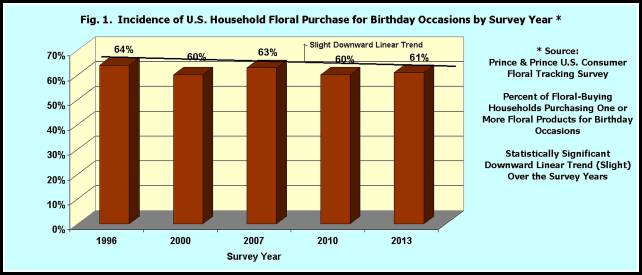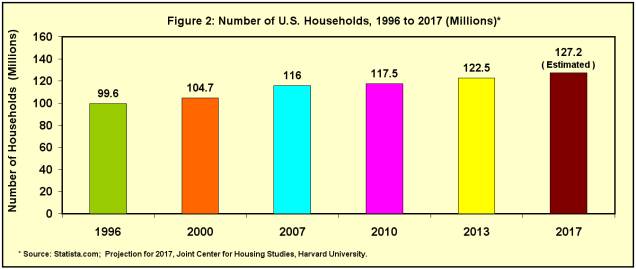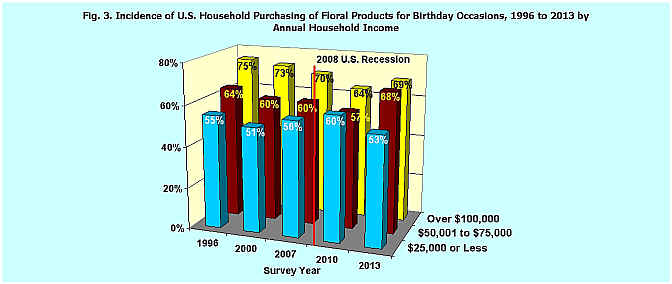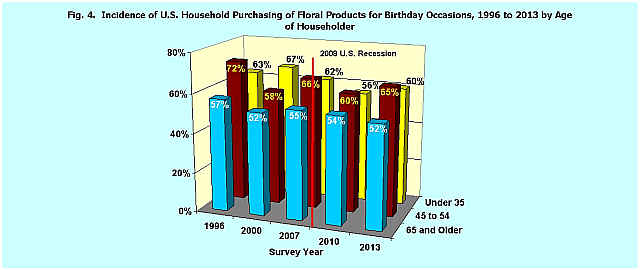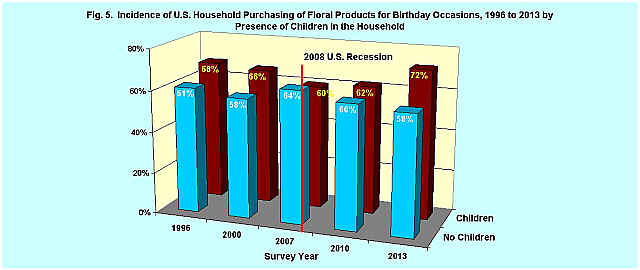|
|
|
U.S. Consumer Floral Purchasing for Birthday Occasions: An Historical Trend Perspective Insight
from the Prince & Prince U.S. Consumer Floral Tracking Survey
Thomas L. Prince, Ph.D. Timothy A. Prince, Ph.D. Prince & Prince, Inc. Columbus, OH USA FloralMktResearch@att.net
614-299-4050 Report Date: October 9th, 2017
U.S. CONSUMER FLORAL PURCHASING FOR BIRTHDAY OCCASIONS: AN HISTORICAL TREND PERSPECTIVE * * The P&P consumer floral research conducted in 2007, 2010, and 2013 was sponsored by Smithers-Oasis, North America (SONA). P&P sincerely thank SONA for their financial support in making this consumer floral research possible, providing benefit for the entire floral industry. The celebration of birthday occasions in the U.S. represents a prime opportunity for consumer floral purchasing, as nearly 325 million people in the U.S. will have a birthday on some particular day in 2017. Fresh cut-flower arrangements, bouquets, blooming potted plants, and foliage plants/ planters are ideal gifts that can add expressive color and excitement to birthday festivities, as well as providing smiles and happiness to the special birthday recipient. In-depth knowledge of consumer floral purchasing trends specifically for birthday occasions may allow the floral industry to more effectively market and promote birthday occasions, and further exploit the market opportunities that these birthday celebrations offer. Prince & Prince, Inc. (P&P), a leader in market research focused on the floral and green plant industries, has been tracking consumer household floral purchasing behavior for birthday occasions (and for 20+ other holidays, events, and occasions) over the past two decades with their periodic surveys of U.S. floral-buying households (each survey comprises over 1,000 randomly-selected U.S. floral-buying households; Prince & Prince, 2014). Thus, P&P is able to identify salient consumer floral-purchasing trends over time, and purchasing trends that are specific to individual floral holidays, occasions and events, including birthday occasions. P&P's next update of the U.S. Consumer Floral Tracking Survey is scheduled for next year, the Summer/ Fall of 2018 (See "2018 P&P Consumer Floral Research Update" at the end of this report). According to P&P market survey estimates, consumer floral purchasing for the birthday occasion is one of the top purchasing occasions for the U.S. floral industry, in terms of the number of floral-buying households that participate in purchasing for this occasion throughout the year. P&P project that for 2017, more than 55 million households in the U.S. will purchase fresh cut flowers (fresh floral arrangements, bouquets, roses, bunches, single stems, and corsages) and/or potted flowering and foliage plants/ planters as a gift for the birthday recipient, or as festive decorations for the birthday event. Unlike floral "holidays" such as Valentine's Day and Mother's Day, the celebration of birthdays occurs everyday throughout the year. Overall Household Incidence of Birthday Floral Purchasing From P&P surveys, the overall percentage of U.S. floral-buying households that will make one or more fresh floral purchases for birthday occasion(s) throughout the year is currently estimated at 61% (Figure 1). This 61% is termed the household incidence of birthday floral purchasing, and includes all members of the household that make one or more fresh floral purchases annually for birthdays in or out of the household. This 61% incidence percentage (based on U.S. floral-buying households) has "bounced" up and down slightly over the years, registering a high of 64% in the 1996 P&P consumer floral survey, and a low of 60% in both the year 2000 and 2010 P&P surveys (Figure 1). However, after conducting statistical trend analysis of the birthday incidence data over the survey years, a slight downward linear trend is evident at the 90% confidence level (1).
1
Data
trends tested using pre-planned, single degree-of-freedom orthogonal
contrasts, testing for linear, quadratic, and cubic trends over time,
using the SPSS MANOVA statistical program. Although the household purchasing incidence for birthday occasions has been trending slightly lower over the survey years (at about a three to four-point percentage drop over a 17 year period), the number of households in the U.S. continues to expand annually (and for future projections too; McCue, 2014), at slightly less than a one-percentage point increase each year (see Figure 2). Thus, the small growth rate of U.S. households compensates for the very slight decline in household purchasing incidence for birthday occasions, resulting in an overall stable to low-growth market for birthday floral purchasing in the U.S.
The very slight downward trend in household floral purchasing for birthdays in the U.S. actually suggests a strong resilience in consumer floral gifting/ decorating for birthday occasions, given the plethora of competing products and services that have been marketed for birthday occasions over the past two decades. The 61% purchasing incidence is still remarkably high, similar to that of the Mother's Day floral holiday, also at 61% (Prince & Prince, 2017). However, that may not be a fair comparison, as birthdays occur throughout the year, and occur for multiple family members in or out of the household, and well as for family friends. Notwithstanding, birthday occasions represent a strong opportunity for consumer floral purchasing in the U.S., and one that should not be under-marketed by the floral industry, just because its sales occurrence is "diluted" throughout the year. Birthday Floral Purchasing by Consumer Demographics To elucidate the dynamics in birthday floral purchasing, P&P segmented the historical purchasing data for birthday occasions by key consumer demographics, including annual household income, age of householder, and presence of children within the household (three of ten demographic characteristics collected in the P&P consumer survey research). These analyses reveal the underlying consumer demand characteristics for birthday floral purchasing, and possibly highlight market opportunities for expanding birthday product sales in the U.S. floral market. Segmentation by Annual Household Income The historical household incidence of birthday floral purchasing segmented by annual household income is shown in Figure 3. For parsimony, only three of five household income categories are shown ($25,000 or less, $50,001 to $75,000, and Over $100,000), however these three income categories largely represent low, middle, and high-income consumer groups in the U.S. The chart also designates the 2008 U.S. recession, which may assist in understanding some of the historical floral purchasing trends over time. In general, the incidence of household floral purchasing for birthday occasions increases with increasing income, but the purchasing trends have varied somewhat over the years. The mid- and highest income segments showed declines in birthday floral purchasing in 2010, after the 2008 recession, but the lowest income segment actually showed increases in household floral purchasing (incidence of purchase) just prior to and after the start of the recession. This data trend suggests that floral is likely a desirable and affordable offering for birthday celebrations in a recessionary climate, especially among lower-income households. By the end of 2013, birthday floral purchasing for the mid- and highest income consumer segments had largely rebounded from the recession, with the $50k to $75k income segment posting it's highest purchasing in nearly two decades (68%), while the lower-income segment retreated to pre-recession levels, possibly due to non-floral birthday competition. For the middle income group ($50k to $75k), statistical trend analysis of the birthday purchasing data over time revealed an upward quadratic trend, suggesting a trend reversal and recent build in birthday floral purchasing for this segment. The quadratic trend for the highest income group was not statistically significant (at the 90% confidence level). The lowest income group revealed a cubic purchasing trend over the survey years, with two trend reversals over the time periods (e.g. down, up, down).
Segmentation by Age of Householder Figure 4 shows historical consumer floral purchasing for birthday occasions segmented by the age of householder. In general, consumers in the middle-age group (aged 45 to 54) generally showed somewhat higher floral purchasing for birthday occasions, compared to younger and older-aged consumer segments across the survey years. Consumer households under the age of 35 showed a rise in birthday floral purchasing during the Y2K boom of year 2000, where many "Twenty-Somethings" earned six-figure incomes related to rapid growth in Web-based businesses, and part of that higher disposable income was evidently spent on floral products. However, younger-aged consumers that were floral-responsive to economic boom, were also floral-responsive to economic decline, as shown by notable declines in birthday floral purchasing after the 2008 recession. By the end of 2013, the younger-aged segment had not yet fully rebounded from the recession, with birthday floral purchasing still below pre-recession levels, but the final trend was up. This "up-down-up" purchasing is supported by trend analysis, where the cubic trend was significant for this age group. The middle-age consumer segment, aged 45 to 54, showed the greatest relative volatility in birthday floral purchasing over the survey years, with relatively higher birthday floral purchasing in the survey years of 1996, 2007, and 2013, and lower purchasing in year 2000, and 2010 (after the 2008 recession). By the end of 2013, this middle-aged consumer segment had largely recovered from the recession, with birthday floral purchasing near pre-recession levels (65%). This recent build in birthday floral purchasing is supported by statistical trend analysis, as a quadratic upward trend best represents this middle age-group data series. The eldest consumer segment, aged 65 and older, could best be described as "stable purchasing", showing no significant trend line (linear, quadratic, or cubic) in purchasing over the survey years. Across the survey years, the household purchase incidence for this eldest age group averaged 54%.
Segmentation
by Presence of Children in the Household The historical consumer floral purchasing for birthday occasions segmented by the presence of children in the household is shown in Figure 5. Across the survey years, the presence of children in the household generally yields somewhat higher floral purchasing for birthday occasions, compared to households without children. Only the survey period just prior to the U.S. recession (2007 data) showed floral birthday purchasing higher among households with no children, but "children purchasing" rebounded by the next survey period (2010). In fact, for the 2013 survey, households with children showed a 14 percentage-point increase in floral birthday purchasing over households without children, the highest across the survey years. Statistical trend analysis conducted on the historical birthday purchasing data yielded a significant quadratic purchasing trend for households with children (curve-shaped increasing trend), and no trend is significant (linear, quadratic, or cubic) for households without children. This finding suggests that since the U.S. recession, birthday floral purchasing for households with children is on a building trend.
Summary The Prince & Prince U.S. Consumer Floral Tracking Survey provides the floral industry valuable statistics on key holidays and events of consumer floral purchasing, including birthday occasions. These birthday occasions, which occur for every household throughout the year, are prime opportunities for consumer floral purchasing, as evidenced by the relatively high incidence of floral purchase currently, and historically, by U.S. households. The demographic segmentation and trend analysis of birthday floral purchasing over time reveals several consumer groups where floral purchases for birthday occasions are trending upward and on the rise (middle-income households, middle-age households, and households with children). This P&P market information on historical household floral purchasing trends benefits the floral industry by allowing it to better target and allocate resources to more lucrative consumer floral-buying segments. 2018 P&P Consumer Floral Research Update Prince & Prince is currently seeking research co-sponsors for a 2023 update of the P&P U.S. Consumer Floral Tracking Survey (See "Consumers 2023" page on the P&P web site for specific survey content.). Research co-sponsors receive the floral market presentation first thru a one-day, on-site seminar with Q&A, and the complete 800+ slide market research presentation on a flash drive. The floral market presentation is tailored to the information needs of the individual research co-sponsors. Research co-sponsors also receive exclusivity of the floral market information for a one-year period following the completion of the research. Interested companies should contact P&P for research sponsorship opportunities. Literature Cited McCue, D. (2014). Baseline Household Projections for the Next Decade and Beyond. Joint Center for Housing Studies, Harvard University. Prince, T.L. and Prince, T.A. (2017). Prince & Prince Project a $4.2 Billion Dollar U.S. Consumer Floral Market for Mother's Day 2017. Columbus, OH: Prince & Prince, Inc. (P&P Market Report). Prince, T.L. and Prince, T.A. (2014). The Prince & Prince U.S. Consumer Floral Tracking Survey, 2014 Edition. Columbus, OH: Prince & Prince, Inc. (P&P On-Site Seminar and Seminar on Flash). About the Authors Drs. Tom and Tim Prince, formerly of The Ohio State University, are brothers and co-founders of Prince & Prince, Inc. (P&P), a leading marketing research specialist in the floral and green plant industries. P&P has completed more than 75 major marketing research projects and countless reports for the floral industry in the U.S., and has also conducted floral market research in Canada, the United Kingdom, Holland, Germany, and Spain. P&P's most recent research efforts involve in-store supermarket floral-product purchasing, and understanding consumer dollar valuation of specific product features that drive overall product value. P&P conceptualize, design, and implement market research projects for floral and green-plant suppliers, hardgood suppliers, floral importers, wholesale florists, retail florists, floral mass-marketers, floral-industry associations, and companies serving the allied floral trade. For more information, visit the P&P web site at www.FloralMarketResearch.com, or e-mail Tom below.
|

